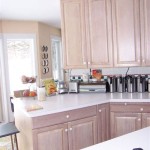Painting Wood Stained Kitchen Cabinets: A Comprehensive Guide
Transforming the look of your kitchen with painted cabinets is a smart and cost-effective solution, but it requires meticulous preparation and execution, especially when the existing cabinets are stained wood. This guide will take you through the essential steps involved in painting wood stained kitchen cabinets, providing you with the knowledge and confidence to achieve a professional-looking finish.
Step 1: Preparation
Thorough preparation is crucial for a successful paint job. Start by cleaning the cabinets with a degreaser to remove any grease or grime. Wear a face mask and gloves for protection. Once the cabinets are clean, use a sanding block or electric sander to lightly sand the surface, creating a rough texture for the paint to adhere to. Avoid sanding too much, as this can damage the wood. Subsequently, use a vacuum cleaner and a tack cloth to remove dust particles.
Step 2: Protect the Workspace
To prevent paint from getting onto the floor or appliances, cover them with drop cloths or plastic sheeting. Secure the coverings with painter's tape for extra protection. Remove the cabinet doors and hardware. Label them for easy reinstallation later.
Step 3: Prime the Cabinets
Primer helps the paint adhere better and provides a solid base color. Apply a coat of primer specifically designed for wood stains, using a paintbrush or roller. Ensure even coverage, especially around edges and corners. Allow the primer to dry completely before proceeding.
Step 4: Paint the Cabinets
Choose a high-quality paint designed for kitchen cabinets. Use a paintbrush or roller and apply two thin coats, allowing ample drying time between each coat. Pay close attention to corners and edges to ensure complete coverage. For a smoother finish, sand lightly between coats using fine-grit sandpaper.
Step 5: Protect the Paint
To protect the painted surface, apply a clear polyurethane topcoat in a matte, satin, or glossy finish, depending on your preference. Use a brush or roller to apply an even coat and allow it to dry thoroughly. This step enhances the durability and resistance of the paint to wear and tear.
Step 6: Reinstall the Components
Once the topcoat is completely dry, reattach the cabinet doors and hardware. Ensure the screws or hinges are secure. Clean the cabinets gently with a damp cloth and polish the hardware for a gleaming finish.
Additional Tips
- Test the paint on an inconspicuous area first to ensure color and finish compatibility.
- Use a paint sprayer for a faster and more even application, but follow the manufacturer's instructions carefully.
- Allow ample drying time between each step to ensure proper adhesion and prevent peeling.
- Clean your brushes and rollers thoroughly after use to avoid paint buildup.
- If you encounter stubborn stains or blemished wood, consider using a wood filler or touch-up paint to restore the surface.
Conclusion
Painting wood stained kitchen cabinets requires meticulous preparation and precision. By following these essential steps and adhering to the additional tips, you can achieve a professional-looking finish that transforms the aesthetics of your kitchen. Remember to work carefully, allow ample drying time, and take pride in your newly painted cabinets.

Painted Vs Stained Cabinets Which Fits Your Style Best

Painted Vs Stained Cabinets Jm Kitchen And Bath Design
/102182203-4cf08265c33b4c4e88fb21315a8fe626.jpg?strip=all)
Our Step By Guide To Beautiful Stained Wood Cabinets

Farmhouse Check In A What We Chose Edition Stained Wood Or Painted Cabinets Emily Henderson

Painted Vs Stained Kitchen Cabinets

Painted Wood Cabinets Vs Stained A Questionnaire Kylie M Interiors

How To Stain Wood Cabinets True Value

Painted Vs Stained Cabinets Jm Kitchen And Bath Design

Should I Paint Or Refinish My Kitchen Cabinets

Staining Your Wood Cabinets Darker Young House Love
Related Posts








